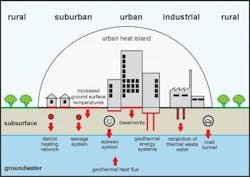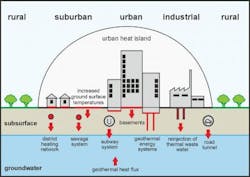Heated groundwater aquifers contain sustainable energies, finds researchers
Oct. 28, 2013 -- A new analytical heat flux model developed by researchers from the Karlsruhe Institute of Technology (KIT) in Karlsruhe, Germany and ETH Zurich in Zürich, Switzerland, has found that sustainable energies for heating in the winter and cooling in the summer may be extracted from heated groundwater aquifers.
The model concluded that increasing heat in the underground is mainly caused by an increase in surface temperatures and heat released from buildings. Temperatures in big cities are far above those in surrounding rural areas; as such, dense settlement, surface sealing, industry, traffic, and lacking vegetation cause an urban microclimate with increased temperatures in the atmosphere.
Accordingly, temperature anomalies also develop in the underground and spread laterally and vertically. In the past decades, groundwater in conurbations heated up considerably. "In Karlsruhe, the average heat flux density into subsurface aquifers was 759 milliwatts per square meter in 1977. In 2011, a heat flux density of 828 milliwatts per square meter was reached," says Junior Professor Philipp Blum, head of the Engineering Geology Division of the KIT Institute of Applied Geosciences (AGW). "This amount of heat corresponds to 1 petajoule per year and would suffice to supply at least 18,000 households in Karlsruhe with heat."
In cooperation with Kathrin Menberg and Axel Schaffitel from KIT and Dr. Peter Bayer from ETH Zurich, Blum also studied the origin of heat in the underground of conurbations. The scientists' heat flux model examined factors such as the increase in temperatures of sealed surfaces, heat release from buildings, sewage ducts, and underground district heating networks as well as discharge of thermal wastewater. By modeling anthropogenic heat fluxes into the underground of the city of Karlsruhe, the researchers determined long-term trends of heat flux processes. They found that the increased surface temperature and heat release from buildings in particular are responsible for the increase in temperatures in the subsurface area.
The energy from close-to-surface groundwater aquifers might be used for heating in the winter and cooling in the summer via geothermal heat pumps and groundwater heat pumps. Use of this geothermal potential would not only cover part of the growing demand for energy, but also reduce the emission of greenhouse gases, which would counteract heating of the cities.
Work of the scientists is now reported in the renowned journal "Environmental Science and Technology" (DOI: 10.1021/es401546u).
###

